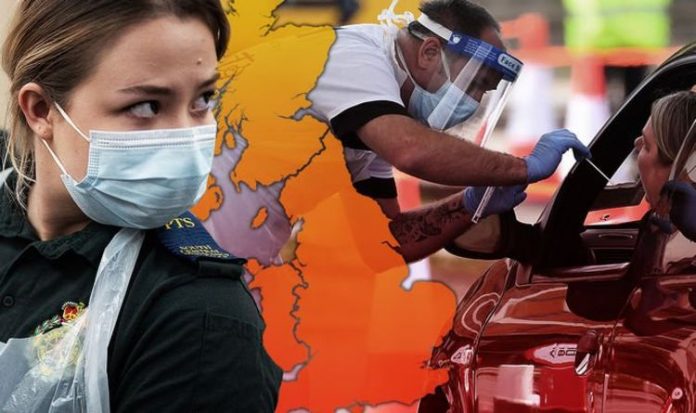Coronavirus cases jumped by nearly 16,000 due to a backlog of infections which were omitted from Public Health England’s daily figures from September 25 to October 2. Express.co.uk has compiled a guide to show where the worst coronavirus hotspots are right now and explain what the current R rate is.
Public Health England said 15,841 cases between September 25 and October 2 were missed from the UK daily case figures.
These cases were added to the figures for Saturday and Sunday.
The technical issue means that daily totals reported on the government’s coronavirus dashboard over the last week have been lower than the true number.
Speaking on Sunday, Prime Minister Boris Johnson has warned it could be “bumpy through to Christmas” and beyond as the UK deals with coronavirus.
He said there was “hope” of combatting COVID-19 and he called on the public to “act fearlessly but with common sense”.
READ MORE: GMB row explodes as Piers clashes with former Trump aide
What is the R rate?
The reproduction number (R rate) is the average number of secondary infections produced by a single infected person.
The latest R rate in the UK is from 1.3 to 1.6 according to the UK Government.
This is an increase from 1.2 to 1.5 for the week before.
This means on average for every 10 people infected, they will infect between 13 and 16 other people.
This update published on Friday, October 2, also revealed the latest growth rate range in the UK was between five and nine percent per day.
The R rate differs per region and as of Friday the estimates for each NHS England region is as follows:
- England : R rate – 1.2 to 1.6 – Growth rate – +4 percent to +8 percent
- East of England: R rate – 1.0 to 1.3 – Growth rate – +1 percent to +6 percent
- London: R rate – 1.2 to 1.6 – Growth rate – +3 percent to +9 percent
- Midlands: R rate – 1.2 to 1.5 – Growth rate – +3 percent to +8 percent
- North East and Yorkshire: R rate – 1.2 to 1.6 – Growth rate – +4 percent to +9 percent
- North West: R rate – 1.2 to 1.5 – Growth rate – +4 percent to +8 percent
- South East: R rate – 1.1 to 1.4 – Growth rate – +2 percent to +6 percent
- South West: R rate – 1.1 to 1.4 – Growth rate – +2 percent to +7 percent.
At least 17 million people are now facing additional restrictions in addition to the national rules in effect across the UK.
This equates to around a quarter of the population including:
- 12.7m people in England, or 23 percent of the population
- 2.4m people in Wales (76 percent)
- 1.8m people in Scotland (32 percent)
- 151,000 people in Northern Ireland (eight percent)
Most of the restrictions in Egland are focused in northern England as well as the midlands,
In total, 66 percent of northern England are under restrictions while 22 percent of the Midlands faces restrictions.
According to the latest weekly surveillance report from Public Health England case rates remain highest in North West and Yorkshire and Humber.
The report based on data from September 21 to September 27, revealed the incidence rate was highest in Newcastle upon Tyne.







